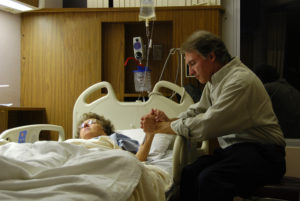
In the state of California, the spouses and registered domestic partners of accident victims may be able to recover compensation for loss of consortium. Read on to learn the definition of loss of consortium and the types of evidence needed to pursue these damages:
Definition of Loss of Consortium
Loss of consortium refers to the loss of love, companionship, comfort, care, assistance, protection, affection, society, moral support, and intimacy (or ability to have children) that individuals suffer as a result of their spouse’s injuries. You may have grounds for a loss of consortium claim if your husband, wife, or registered domestic partner was injured due to someone else’s negligence or intentional wrongdoing. If the injury occurred due to a dog bite or defective product, proving negligence or intent might not be necessary to pursue loss of consortium damages since strict liability applies to these cases.
To recover damages for loss of consortium, your attorney will have to prove that one of the following is true:
- Your spouse has been especially irritable, moody, or touchy;
- You have been depressed or stressed out and your spouse has been unable to counsel or encourage you;
- Your spouse has been unable to help with domestic duties, so you’ve had to take on all household chores;
- You and your spouse have been unable to participate in favorite hobbies or activities together;
- You and your spouse have been unable to have sexual relations; or
- Your spouse has been unable to assist with childrearing, so you’ve had to handle everything from meal preparation to homework help on your own.
You might have noticed that all of the scenarios mentioned above involve intangible non-economic damages. Unfortunately, California law does not permit the spouse of a personal injury victim to pursue economic damages. Even if you suffer objectively verifiable costs—for example, lost work time due to caring for your injured spouse—you won’t be able to recover compensation for those damages; however, your husband or wife can include the value of your services, such as nursing care or domestic help, in his or her own settlement calculations. As a result, you may still recover compensation for such losses as a couple.
Proving Loss of Consortium
In order to file a successful loss of consortium claim, you must prove the following elements:
- A valid and lawful marriage (or registered domestic partnership) existed between you and the injured party when the cause of action accrued;
- Your spouse (or registered domestic partner) sustained a tortious injury;
- You suffered non-economic damages as a direct result of the injury; and
- The defendant’s conduct was the proximate cause of the injury and, subsequently, your loss of consortium damages.
The strongest evidence will depend on the specifics of your case, but generally speaking, your lawyer might use the following evidence to prove loss of consortium:
- A copy of your marriage certificate;
- Your spouse’s medical records including diagnostic images and photographs of any visible wounds;
- Journal entries detailing the daily struggles you now face;
- Statements from specialists explaining the extent of your spouse’s injuries; and
- Statements from medical experts explaining your spouse’s prognosis and the anticipated stages of recovery.
To prove the fourth element—that the defendant’s conduct was the proximate cause of your loss of consortium—your attorney will rely on the same kinds of evidence used to prove liability in your spouse’s claim. Such evidence might include:
- Eyewitness testimony;
- Photographs of the accident scene;
- Surveillance recordings or dash cam footage;
- The official police report;
- The results of any chemical tests conducted at the scene; and
- Statements from accident reconstruction experts.
Quantifying Loss of Consortium
Because loss of consortium is intangible, determining the total value of these damages can be challenging. After all, there are no records, receipts, or invoices tracking the love, companionship, or affection you’ve lost since the accident. As a result, there’s no one-size-fits-all formula for quantifying such damages.
There are, however, a few factors that usually play a role in the calculations. Examples include:
- The injured party’s new quality of life;
- The quality of the marriage prior to the injury;
- The couple’s history regarding separation, divorce filings, infidelity, and domestic violence;
- The couple’s living arrangements;
- The couple’s plans, especially regarding children, prior to the incident and their ability—or lack thereof—to implement such plans after; and
- The extent of any ongoing care that the injured party will require.
Naturally, cases involving more serious injuries typically warrant higher payouts for loss of consortium. Even if your spouse didn’t suffer permanent injuries, though, you may be entitled to at least some compensation for the non-economic damages you incur while he or she is recovering.
If your spouse decides not to file a personal injury claim, you may still be able to recover compensation for loss of consortium. Although related, these two actions are independent of each other. But if your spouse does file a claim and ends up losing, you won’t be able to recover damages for loss of consortium.
Discuss Your Case with a Personal Injury Attorney in Long Beach
Your Injuries Are Personal to Me
As you can see, proving loss of consortium damages can be challenging, and the relevant laws and statutes are highly complex. But with the help of a skilled personal injury attorney, you might be able to recover compensation for loss of love, affection, and other intangible damages you’ve suffered due to your loved one’s injury.
Attorney Michael D. Waks knows what it takes to prove loss of consortium, and he can take the necessary steps to maximize the potential value of your claim. Michael has been representing the injured and their families for more than three decades. Call (562) 206-1939 to schedule a free consultation, or use our Contact Form to send us a message online.